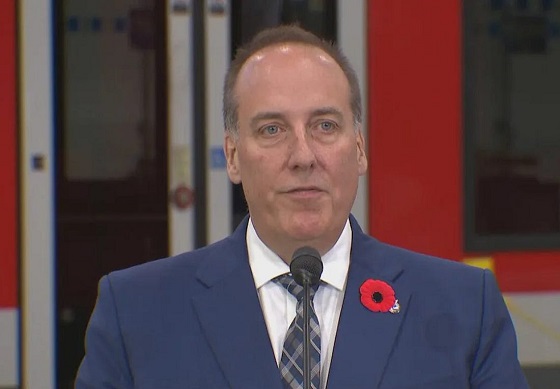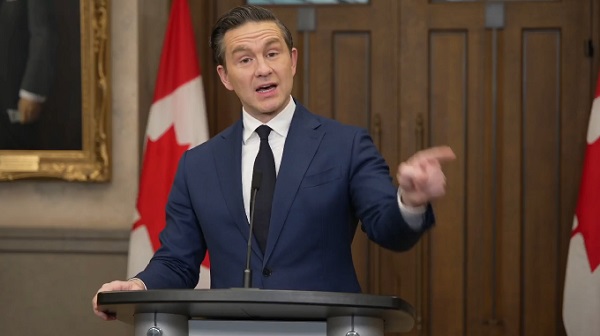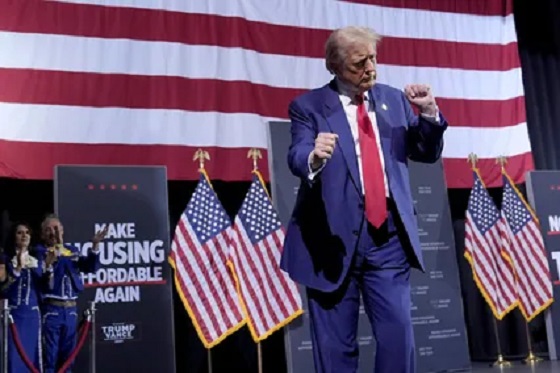Uncategorized
Trump pleads on TV for wall money; Dems say he stokes ‘fear’

WASHINGTON — President Donald Trump urged congressional Democrats to fund his long-promised border wall in a
Speaking to the nation from the Oval Office for the first time, Trump argued Tuesday night that the wall was needed to resolve a security and humanitarian “crisis,” blaming illegal immigration for what he said was a scourge of drugs and violence in the U.S. and asking: “How much more American blood must we shed before Congress does its job?”
Democrats in response accused Trump appealing to “fear, not facts” and manufacturing a border crisis for political gain.
Using the formal trappings of the White House, Trump hoped to gain the upper hand in the standoff over his demand for $5.7 billion to build a wall along the U.S.-Mexico border. He plans a visit to the border Thursday as he continues to pitch what was a signature promise of his 2016 presidential campaign.
He addressed the nation as the shutdown stretched through its third week, with hundreds of thousands of federal workers going without pay and some congressional Republicans growing increasingly jittery about the spreading impact of the impasse. Trump will visit the Capitol on Wednesday to meet with Senate Republicans, and has invited Democratic and Republican congressional leaders to return to the White House to meet with him later that day.
He claimed the standoff could be resolved in “45 minutes” if Democrats would just negotiate, but previous meetings have led to no agreement.
For now, Trump sees this as winning politics. TV networks had been reticent about providing him airtime to make what some feared would be a purely political speech. And that concern was heightened by the decision Tuesday by Trump’s re-election campaign to send out fundraising emails and text messages to supporters trying to raise money off the speech. Their goal: a half-million dollars in a day.
“I just addressed the nation on Border Security. Now need you to stand with me,” read one message sent out after his remarks.
In their own televised remarks, Democratic House Speaker Nancy Pelosi and Senate Minority Leader Chuck Schumer accused Trump of misrepresenting the situation on the border as they urged him to reopen closed government departments and turn loose paychecks for hundreds of thousands of workers.
Negotiations on wall funding could proceed in the meantime, they said.
Schumer said Trump “just used the backdrop of the Oval Office to manufacture a crisis, stoke fear and divert attention from the turmoil in his administration.”
In his dire address, Trump ticked off a string of statistics and claims to make his case that there is a crisis at the border, but a number of his statements were misleading, such as saying the new trade deal with Mexico would pay for the wall, or suggesting through gruesome examples that immigrants are more likely to commit crime.
Trump, who has long railed against illegal immigration at the border, has recently seized on humanitarian concerns to argue there is a broader crisis that can only be solved with a wall. But critics say the security risks are overblown and the administration is at least partly to blame for the humanitarian situation.
Trump used emotional language, referring to Americans who were killed by people in the country illegally, saying: “I’ve met with dozens of families whose loved ones were stolen by illegal immigration. I’ve held the hands of the weeping mothers and embraced the grief-stricken fathers. So sad. So terrible.”
The president often highlights such incidents, though studies over several years have found immigrants are less likely to commit crimes than people born in the United States.
Trump has been discussing the idea of declaring a national emergency to allow him to move forward with the wall without getting congressional approval for the billions he’s requested. But he did not mention that Tuesday night.
The partial government shutdown reached its 18th day on Tuesday, making the closure the second-longest in history, and continued on Wednesday. Hundreds of thousands of federal workers are going without pay, and government disruptions are hitting home with everyday Americans.
Trump was nearly halfway through his 9-minute address before he ever mentioned the border wall, describing it as a request from law enforcement rather than his own longstanding political pledge. He also suggested that his proposal to build the wall from steel, rather than concrete, was a concession to Democrats, although they don’t see it that way.
Trump sought to put the blame on Democrats for the standoff, saying they “will not fund border security.” In fact, House Democrats passed legislation the day they took control of the House that offered $1.3 billion for border security. And Senate Democrats have approved similar funding year after year.
Seeking to keep up pressure on Trump and the Republicans, Pelosi said the House would begin passing individual bills this week to reopen some federal agencies, starting with the Treasury Department to ensure Americans receive their tax refunds. The administration says it will act on its own to ensure the refunds.
Ahead of the speech, the White House sought to shore up GOP support on Capitol Hill, where a growing number of Republicans have been expressing unease with the extended shutdown. But GOP lawmakers were still raising concerns Tuesday, talking about disruptions in payments to farmers and troubles for home buyers trying to get government-backed mortgage loans.
He also told the group that Trump won’t retreat. “That pickup ain’t got reverse in it,” he said.
___
Associated Press writers Colleen Long, Alan Fram and Deb Riechmann contributed to this report.
For AP’s complete coverage of the U.S. government shutdown: https://apnews.com/GovernmentShutdown
Catherine Lucey, Jill Colvin And Lisa Mascaro, The Associated Press
Uncategorized
Trump Admin Establishing Council To Make Buildings Beautiful Again


From the Daily Caller News Foundation
By Jason Hopkins
The Trump administration is creating a first-of-its-kind task force aimed at ushering in a new “Golden Age” of beautiful infrastructure across the U.S.
The Department of Transportation (DOT) will announce the establishment of the Beautifying Transportation Infrastructure Council (BTIC) on Thursday, the Daily Caller News Foundation exclusively learned. The BTIC seeks to advise Transportation Secretary Sean Duffy on design and policy ideas for key infrastructure projects, including highways, bridges and transit hubs.
“What happened to our country’s proud tradition of building great, big, beautiful things?” Duffy said in a statement shared with the DCNF. “It’s time the design for America’s latest infrastructure projects reflects our nation’s strength, pride, and promise.”
“We’re engaging the best and brightest minds in architectural design and engineering to make beautiful structures that move you and bring about a new Golden Age of Transportation,” Duffy continued.
Mini scoop – here is the DOT’s rollout of its Beautifying Transportation Infrastructure Council, which will be tasked with making our buildings beautiful again. pic.twitter.com/
9iV2xSxdJM — Jason Hopkins (@jasonhopkinsdc) October 23, 2025
The DOT is encouraging nominations of the country’s best architects, urban planners, artists and others to serve on the council, according to the department. While ensuring that efficiency and safety remain a top priority, the BTIC will provide guidance on projects that “enhance” public areas and develop aesthetic performance metrics.
The new council aligns with an executive order signed by President Donald Trump in August 2025 regarding infrastructure. The “Making Federal Architecture Beautiful Again” order calls for federal public buildings in the country to “respect regional architectural heritage” and aims to prevent federal construction projects from using modernist and brutalist architecture styles, instead returning to a classical style.
“The Founders, in line with great societies before them, attached great importance to Federal civic architecture,” Trump’s order stated. “They wanted America’s public buildings to inspire the American people and encourage civic virtue.”
“President George Washington and Secretary of State Thomas Jefferson consciously modeled the most important buildings in Washington, D.C., on the classical architecture of ancient Athens and Rome,” the order continued. “Because of their proven ability to meet these requirements, classical and traditional architecture are preferred modes of architectural design.”
The DOT invested millions in major infrastructure projects since Trump’s return to the White House. Duffy announced in August a $43 million transformation initiative of the New York Penn Station in New York City and in September unveiledmajor progress in the rehabilitation and modernization of Washington Union Station in Washington, D.C.
The BTIC will comprise up to 11 members who will serve two-year terms, with the chance to be reappointed, according to the DOT. The task force will meet biannually. The deadline for nominations will end Nov. 21.
Uncategorized
New report warns WHO health rules erode Canada’s democracy and Charter rights

The Justice Centre for Constitutional Freedoms has released a new report titled Canada’s Surrender of Sovereignty: New WHO health regulations undermine Canadian democracy and Charter freedoms. Authored by Nigel Hannaford, a veteran journalist and researcher, the report warns that Canada’s acceptance of the World Health Organization’s (WHO) revised International Health Regulations (IHR) represents a serious erosion of national independence and democratic accountability.
The IHR amendments, which took effect on September 19, 2025, authorize the WHO Director-General to declare global “health emergencies” that could require Canada to follow directives from bureaucrats in Geneva, bypassing the House of Commons and the will of Canadian voters.
The WHO regards these regulations as “binding,” despite having no ability or legal authority to impose such regulations. Even so, Canada is opting to accept the regulations as binding.
By accepting the WHO’s revised IHR, the report explains, Canada has relinquished its own control over future health crises and instead has agreed to let the WHO determine when a “pandemic emergency” exists and what Canada must do to respond to it, after which Canada must report back to the WHO.
In fact, under these International Health Regulations, the WHO could demand countries like Canada impose stringent freedom-violating health policies, such as lockdowns, vaccine mandates, or travel restrictions without debate, evidence review, or public accountability, the report explains.
Once the WHO declares a “Pandemic Emergency,” member states are obligated to implement such emergency measures “without delay” for a minimum of three months.
Importantly, following these WHO directives would undermine government accountability as politicians may hide behind international “commitments” to justify their actions as “simply following international rules,” the report warns.
Canada should instead withdraw from the revised IHR, following the example of countries like Germany, Austria, Italy, Czech Republic, and the United States. The report recommends continued international cooperation without surrendering control over domestic health policies.
Constitutional lawyer Allison Pejovic said, “[b]y treating WHO edicts as binding, the federal government has effectively placed Canadian sovereignty on loan to an unelected international body.”
“Such directives, if enforced, would likely violate Canadians’ Charter rights and freedoms,” she added.
Mr. Hannaford agreed, saying, “Canada’s health policies must be made in Canada. No free and democratic nation should outsource its emergency powers to unelected bureaucrats in Geneva.”
The Justice Centre urges Canadians to contact their Members of Parliament and demand they support withdrawing from the revised IHR to restore Canadian sovereignty and reject blind compliance with WHO directives.
-

 Business2 days ago
Business2 days agoWill Paramount turn the tide of legacy media and entertainment?
-

 Alberta2 days ago
Alberta2 days agoFederal budget: It’s not easy being green
-

 Health23 hours ago
Health23 hours agoLack of adequate health care pushing Canadians toward assisted suicide
-

 National15 hours ago
National15 hours agoWatchdog Demands Answers as MP Chris d’Entremont Crosses Floor
-

 Alberta15 hours ago
Alberta15 hours agoATA Collect $72 Million in Dues But Couldn’t Pay Striking Teachers a Dime
-

 Artificial Intelligence15 hours ago
Artificial Intelligence15 hours agoAI seems fairly impressed by Pierre Poilievre’s ability to communicate
-

 Energy2 days ago
Energy2 days agoA picture is worth a thousand spreadsheets
-

 Energy2 days ago
Energy2 days agoIt should not take a crisis for Canada to develop the resources that make people and communities thrive.









